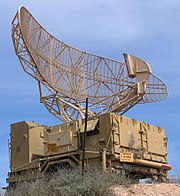
Radar
For other uses, see Radar (disambiguation).
Radar is a detection system that uses radio waves to determine the range, angle, or velocity of objects. It can be used to detect aircraft, ships, spacecraft, guided missiles, motor vehicles, weather formations, and terrain. A radar system consists of a transmitter producing electromagnetic waves in the radio or microwaves domain, a transmitting antenna, a receiving antenna (often the same antenna is used for transmitting and receiving) and a receiver and processor to determine properties of the object(s). Radio waves (pulsed or continuous) from the transmitter reflect off the object and return to the receiver, giving information about the object’s location and speed.

Long-range radar antenna, used to track space objects and ballistic missiles.

Radar of the type used for detection of aircraft. It rotates steadily, sweeping the airspace with a narrow beam.
Radar was developed secretly for military use by several nations in the period before and during World War II. A key development was the cavity magnetron in the United Kingdom, which allowed the creation of relatively small systems with sub-meter resolution. The term RADAR was coined in 1940 by the United States Navy as an acronym for “RAdio Detection And Ranging”.[1][2] The term radar has since entered English and other languages as a common noun, losing all capitalization. During RAF RADAR courses in 1954/5 at Yatesbury Training Camp “radio azimuth direction and ranging” was suggested.[citation needed] The modern uses of radar are highly diverse, including air and terrestrial traffic control, radar astronomy, air-defense systems, antimissile systems, marine radars to locate landmarks and other ships, aircraft anticollision systems, ocean surveillance systems, outer space surveillance and rendezvous systems, meteorological precipitation monitoring, altimetry and flight control systems, guided missile target locating systems, self-driving cars, and ground-penetrating radar for geological observations. High tech radar systems are associated with digital signal processing, machine learning and are capable of extracting useful information from very high noise levels.
Other systems similar to radar make use of other parts of the electromagnetic spectrum. One example is LIDAR, which uses predominantly infrared light from lasers rather than radio waves. With the emergence of driverless vehicles, radar is expected to assist the automated platform to monitor its environment, thus preventing unwanted incidents.[3]